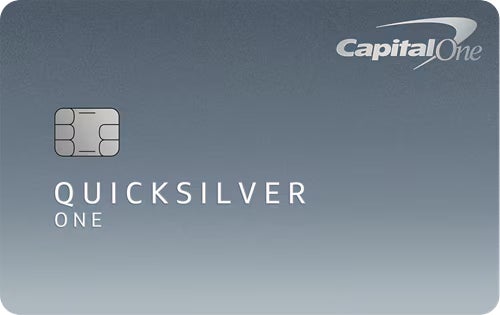| Credit Building Rating: | 3.9 / 5 |
| Cost of Membership | 5.0 |
| Ease of Building Credit | 3.0 |
| APR | 2.0 |
| Features | 5.0 |
In a Nutshell:
The Capital One QuicksilverOne card is one of our top choices for consumers trying to bolster their credit scores, thanks to a generous rewards program that offers 1.5% cash back on every purchase and easily makes up for the card’s annual fee.
Average Cost Of Membership Per Year ($3,600 annual spend) |  |
Security Deposit Required |  |
Credit Limit |  |
Access To Higher Credit Line? |  |
APR 29.74% (Variable) See rates and Fees |  |
Annual Fee |  |
Other Rates And Fees
|  |
Rewards
|  |
Other Notable Features: Possible credit limit increase after 6 months of on on-time payments, security and account alerts, personalized due date, compatible with Apple Pay, no foreign transaction fees, $0 fraud liability on unauthorized charges, emergency card services, Mastercard ID Theft Protection (See rates and Fees)
Cardholders with average credit don’t have to settle for limited benefits and stingy rewards with this user-friendly cash back card. For $39 a year (See rates and Fees), the QuicksilverOne card offers many of the same benefits as cards for consumers with excellent credit, including an unlimited cash bonus on every purchase and card benefits such as fraud coverage and identity theft protection.
If you who plan to carry a balance, though, you may want to steer clear. The QuicksilverOne card’s APR is high, making it a risky choice for everyday spending.
See related: Capital One Quicksilver vs. QuicksilverOne
Simple rewards for busy cardholders
For cardholders who want to earn a considerable amount of cash back and don’t want to mess with complicated rewards schemes, the QuicksilverOne card is an attractive choice. It not only offers unlimited 1.5% cash back on every purchase, but also 5% back on hotels and rental cars booked through Capital One Travel. That’s a very generous rate for a credit-building card and your cash back could add up quickly, especially if you use credit to pay for all or most of your purchases. The cash rewards don’t expire either, so you’re also free to build up your rewards slowly if you prefer to only use your card for occasional purchases.
Card benefits
In addition to credit-building perks like the opportunity to increase your credit limit if you make six consecutive on-time payments, the QuicksilverOne card offers a handful of benefits that could come in handy in the event of an emergency, including $0 fraud liability on unauthorized charges and emergency card replacement should your card be lost or stolen, as well as assistance should you become the victim of identity theft.
Few promotions
The QuicksilverOne card doesn’t offer a sign-up bonus, though, so you may have to wait to redeem a significant amount of cash. Many cash back credit card competitors offer sign-up bonuses that are worth at least $100 or more; however, those cards are typically geared for cardholders with excellent credit.
Pricey terms
The biggest downside to the QuicksilverOne card is its expensive APR, which is well above average for a rewards card. This is a good card to use for everyday purchases if you’re disciplined enough to only use it for purchases you can afford to repay immediately. But if you plan to carry a balance, or have so little savings that a financial emergency would force you to rely on credit to tide you over, this is a risky card to choose.
Why get the QuicksilverOne card?
- You want a higher earning cash back card, but have less-than-perfect credit
- You want a simpler card with a low maintenance rewards program.
- You want to earn cash back for everyday purchases and plan to pay off your purchases in full.
How to use the QuicksilverOne card:
- Avoid the card’s high interest rate by paying off each credit card bill in full.
- Pay every bill on time in order to receive a credit limit increase and to boost your credit score.
- Save time by opting in to automatic cash redemption.
For Capital One products listed on this page, some of the benefits may be provided by Visa® or Mastercard® and may vary by product. See the respective Guide to Benefits for details, as terms and exclusions apply.
Our reviews and best card recommendations are based on an objective rating process and are not driven by advertising dollars. However, we do receive compensation when you click on links to products from our partners. Learn more about our advertising policy
All reviews are prepared by CreditCards.com staff. Opinions expressed therein are solely those of the reviewer and have not been reviewed or approved by any advertiser. The information, including card rates and fees, presented in the review is accurate as of the date of the review. Check the data at the top of this page and the bank’s website for the most current information.
Responses to comments in the discussion section below are not provided, reviewed, approved, endorsed or commissioned by our financial partners. It is not our partner’s responsibility to ensure all posts or questions are answered.
Partner Offer: carefully review product terms on Capital One's site before applying
